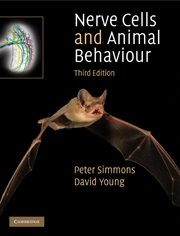Book contents
- Frontmatter
- Contents
- Preface
- 1 Organisation of animal behaviour and of brains: feeding in star-nosed moles and courtship in fruit flies
- 2 Signals in nerve cells: reflexes in mammals and insects
- 3 Neuronal mechanisms for releasing behaviour: predator and prey – toad and cockroach
- 4 Neuronal pathways for behaviour: startle behaviours and giant neurons in crayfish and fish
- 5 Eyes and vision: sensory filtering and course control in insects
- 6 Sensory maps: hunting by owls and bats
- 7 Programmes for movement: how nervous systems generate and control rhythmic movements
- 8 Changes in nerve cells and behaviour: learning in bees and rats; swarming in locusts
- 9 Nerve cells and animal signalling: songs of crickets, electric fish and birds
- References
- Index
- References
9 - Nerve cells and animal signalling: songs of crickets, electric fish and birds
Published online by Cambridge University Press: 05 August 2012
- Frontmatter
- Contents
- Preface
- 1 Organisation of animal behaviour and of brains: feeding in star-nosed moles and courtship in fruit flies
- 2 Signals in nerve cells: reflexes in mammals and insects
- 3 Neuronal mechanisms for releasing behaviour: predator and prey – toad and cockroach
- 4 Neuronal pathways for behaviour: startle behaviours and giant neurons in crayfish and fish
- 5 Eyes and vision: sensory filtering and course control in insects
- 6 Sensory maps: hunting by owls and bats
- 7 Programmes for movement: how nervous systems generate and control rhythmic movements
- 8 Changes in nerve cells and behaviour: learning in bees and rats; swarming in locusts
- 9 Nerve cells and animal signalling: songs of crickets, electric fish and birds
- References
- Index
- References
Summary
When an animal attracts a mate or declares its ownership of a territory, it has to advertise. Signals used in communication usually have clearly defined functions, and signalling behaviour is sometimes associated with clear specialisations within the nervous system. Not only does the animal that sends signals need to make the meaning of its signals clear, but also the animals for which the signals are intended need to be able to capture, interpret and respond appropriately to those signals. So, during evolution, the motor signals that individuals of a species use to create signals need to be matched by appropriate sensory filters to recognise the same signals. For these and other reasons, communication is a fruitful area for investigation by neuroethologists.
In this chapter, we shall describe three different groups of animals that specialise in making and receiving particular types of signal. Two of these, crickets and song birds, use songs – extended patterned sounds – for communication. The other group are electric fish, which broadcast waves or pulses of electrical voltage in the water rather than audible sounds. The function of these electrical signals is not only to communicate with each other, but also to investigate their nearby surroundings. Sound and electric signals share the advantage that they can be used in conditions when sight is of limited use, such as at night or in undergrowth.
- Type
- Chapter
- Information
- Nerve Cells and Animal Behaviour , pp. 222 - 261Publisher: Cambridge University PressPrint publication year: 2010



